HISTORY OF SOME OF THE ILLUMINATING APPARATUS FOR MICROSCOPES

Please Click On Any Picture Below for a Larger Version and/or More Information
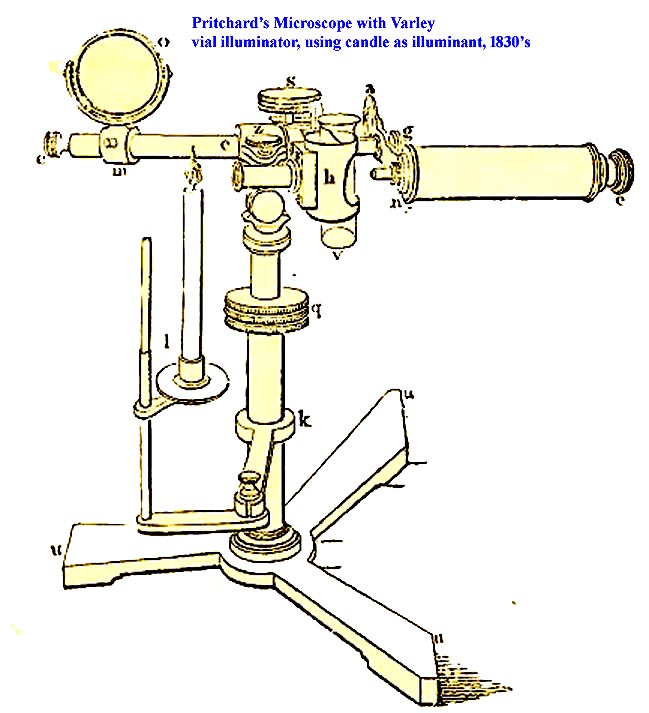
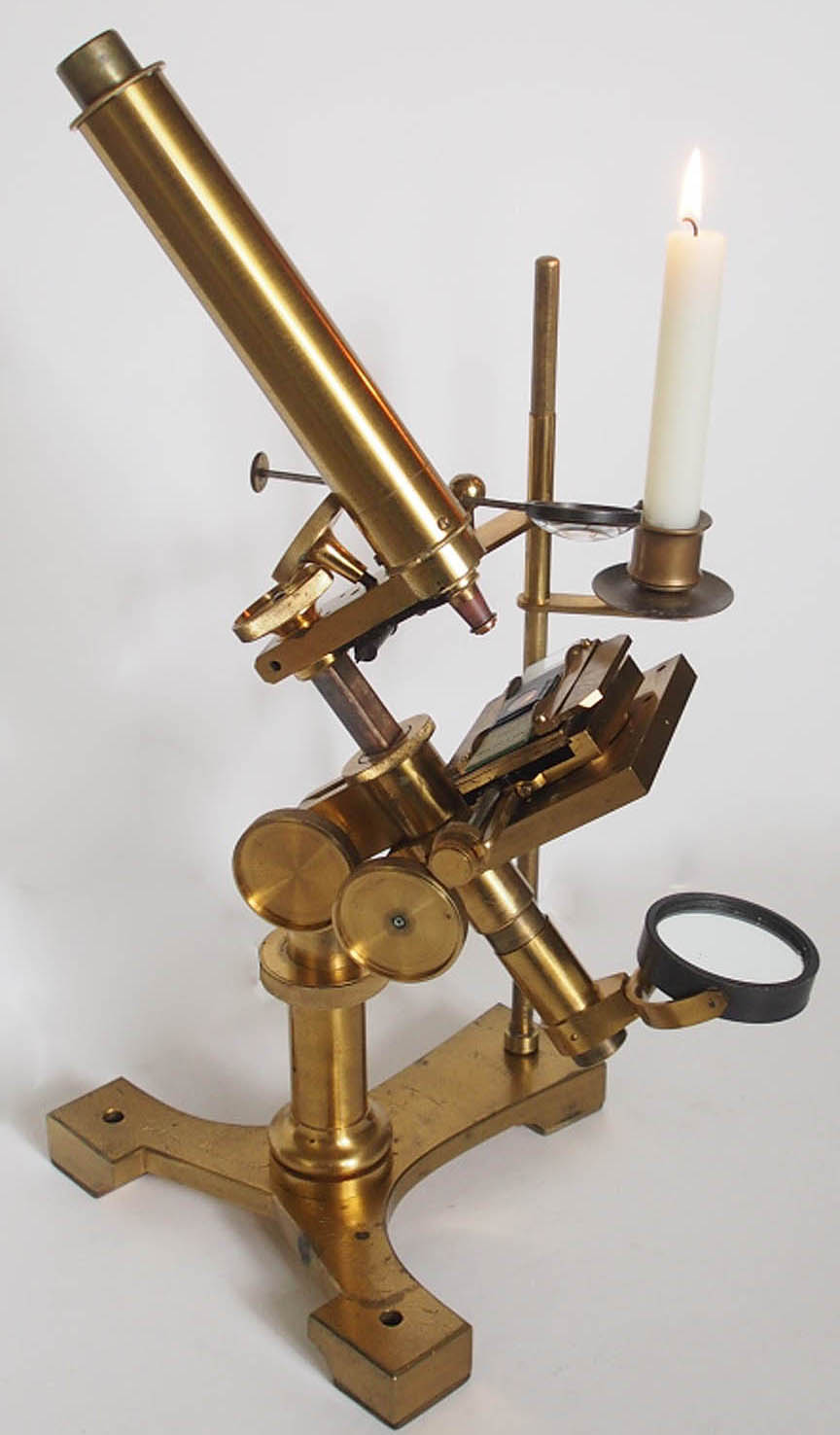 From the earliest days of the microscope, artificial illumination was common, particularly on cloudy days or at night. At the times of the first microscopes, candles and oil lamps were the earliest illuminants. Candles were at first made from tallow, an animal fat derivative which did not burn very brightly and gave off foul smelling fumes. Starting in the late 18th century, the first major change in candlemaking since the Middle Ages occurred, when spermaceti, a wax obtained(unfortunately) by crystallizing sperm whale oil, became available in quantity. The spermaceti wax did not elicit a repugnant odor when burned, and produced a significantly brighter light. These more expensive candles were bright enough to allow better use of the microscope by candle light. Candles could be used on a separate stand designed to hold them, or a device using the microscope's own support could form the basis of the candle holder, as shown in these images. When a candle was used as the light source, a shade was often used to block the direct candle light from the eyes. An example of one of these shades is shown on the candle illumination page. Starting in the second half of the 19th century, distillation of coal oil left behind a sold residue of parafin. This became the standard material for candles.
Today, most candles are made from paraffin wax, now a byproduct of petroleum refining. Candles can also be made from beeswax, gel (a mixture of polymer and mineral oil), or some plant waxes like palm, carnuba etc. Beeswax has always been expensive however.
From the earliest days of the microscope, artificial illumination was common, particularly on cloudy days or at night. At the times of the first microscopes, candles and oil lamps were the earliest illuminants. Candles were at first made from tallow, an animal fat derivative which did not burn very brightly and gave off foul smelling fumes. Starting in the late 18th century, the first major change in candlemaking since the Middle Ages occurred, when spermaceti, a wax obtained(unfortunately) by crystallizing sperm whale oil, became available in quantity. The spermaceti wax did not elicit a repugnant odor when burned, and produced a significantly brighter light. These more expensive candles were bright enough to allow better use of the microscope by candle light. Candles could be used on a separate stand designed to hold them, or a device using the microscope's own support could form the basis of the candle holder, as shown in these images. When a candle was used as the light source, a shade was often used to block the direct candle light from the eyes. An example of one of these shades is shown on the candle illumination page. Starting in the second half of the 19th century, distillation of coal oil left behind a sold residue of parafin. This became the standard material for candles.
Today, most candles are made from paraffin wax, now a byproduct of petroleum refining. Candles can also be made from beeswax, gel (a mixture of polymer and mineral oil), or some plant waxes like palm, carnuba etc. Beeswax has always been expensive however.
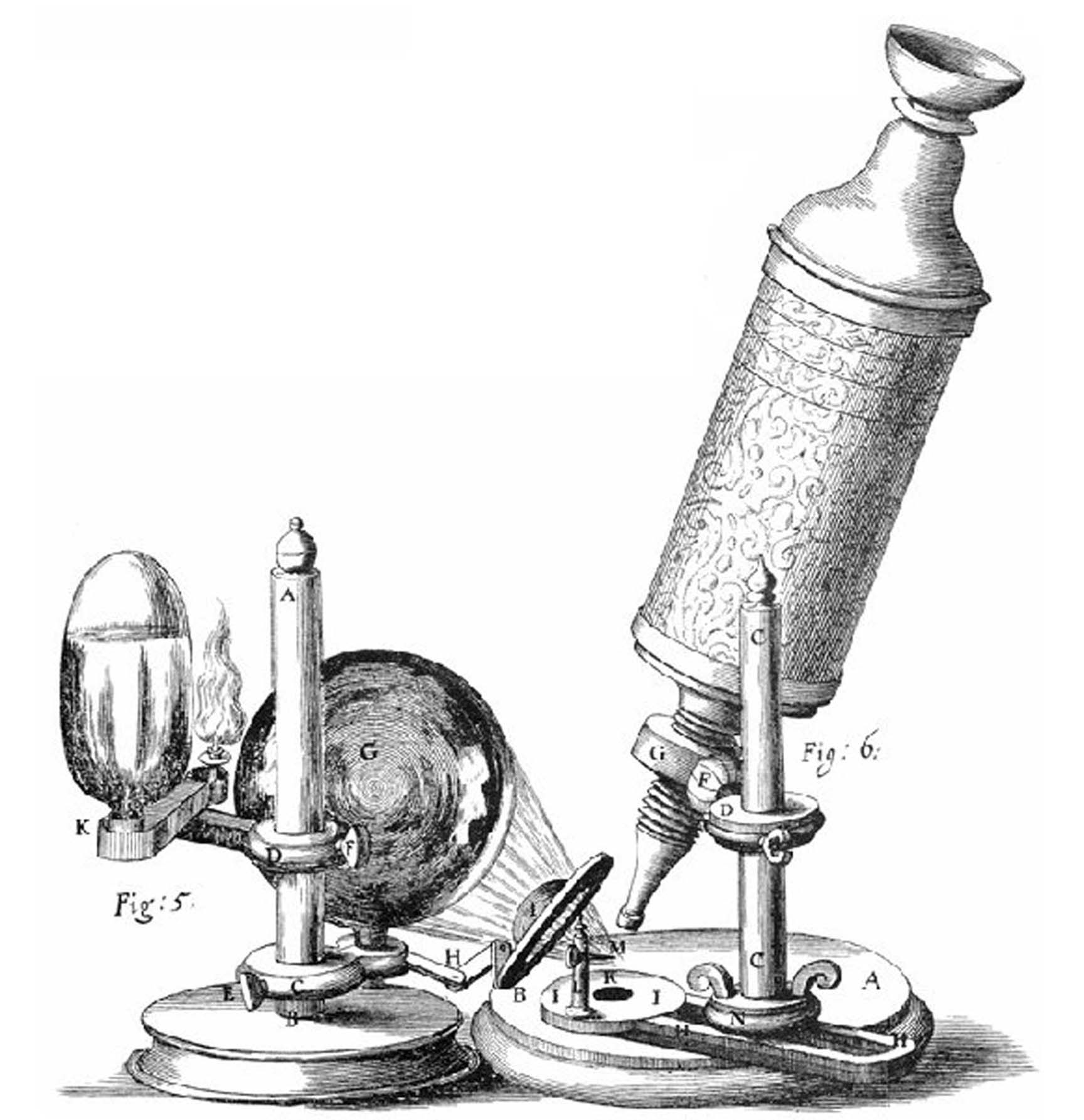 As illustrated by Hooke's book of 1665, Micrographia, oil lamps were also used early on. These early lamps burned with an irregular flame and produced considerable smoke. Even at this early date, the light of the flame was intensified through the use of large lenses, in Hooke's case first through a water-filled glass globe serving to concentrate the light. This early practice of using optical means to intensify and concentrate the light gave rise to the later 'bullseye' condenser. Higher quality oil was also relatively expensive until the discovery of Kerosene* in 1859. As illustrated by the Pritchard microscope from the mid-19th century shown in the preceding paragraph, the use of candles overlapped with oil lamps for a considerable period of time. Among oils used for the lamps early on were olive oil, whale oil, colza oil(from the seeds of Brassica arvensis), and other oils derived from animals. These oils are highly viscous and early lamps using these oils burned with variable flame intensity and with much smoke.
As illustrated by Hooke's book of 1665, Micrographia, oil lamps were also used early on. These early lamps burned with an irregular flame and produced considerable smoke. Even at this early date, the light of the flame was intensified through the use of large lenses, in Hooke's case first through a water-filled glass globe serving to concentrate the light. This early practice of using optical means to intensify and concentrate the light gave rise to the later 'bullseye' condenser. Higher quality oil was also relatively expensive until the discovery of Kerosene* in 1859. As illustrated by the Pritchard microscope from the mid-19th century shown in the preceding paragraph, the use of candles overlapped with oil lamps for a considerable period of time. Among oils used for the lamps early on were olive oil, whale oil, colza oil(from the seeds of Brassica arvensis), and other oils derived from animals. These oils are highly viscous and early lamps using these oils burned with variable flame intensity and with much smoke.
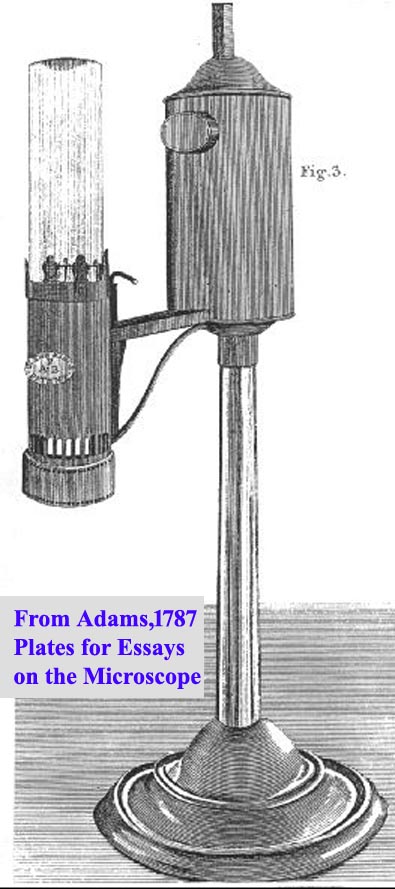
About 1782 the Swiss scientist Aimee Argand invented the lamp named after him. This type of lamp, still using these thick oils, produced a steady higher intensity of flame and much less soot. A key element of this lamp is the reservoir sitting above the burner, improves the feed of the viscous oil through gravity resulting in a brighter steadier flame. The Argand oil lamp shown in the 1787 plates of Adams 'Essays on the Microscope' illustrates that Argand-type lamps were quickly adapted for use with the microscope, even in the 18th century. Even in the mid 19th century, John Queckett used an Argand lamp.
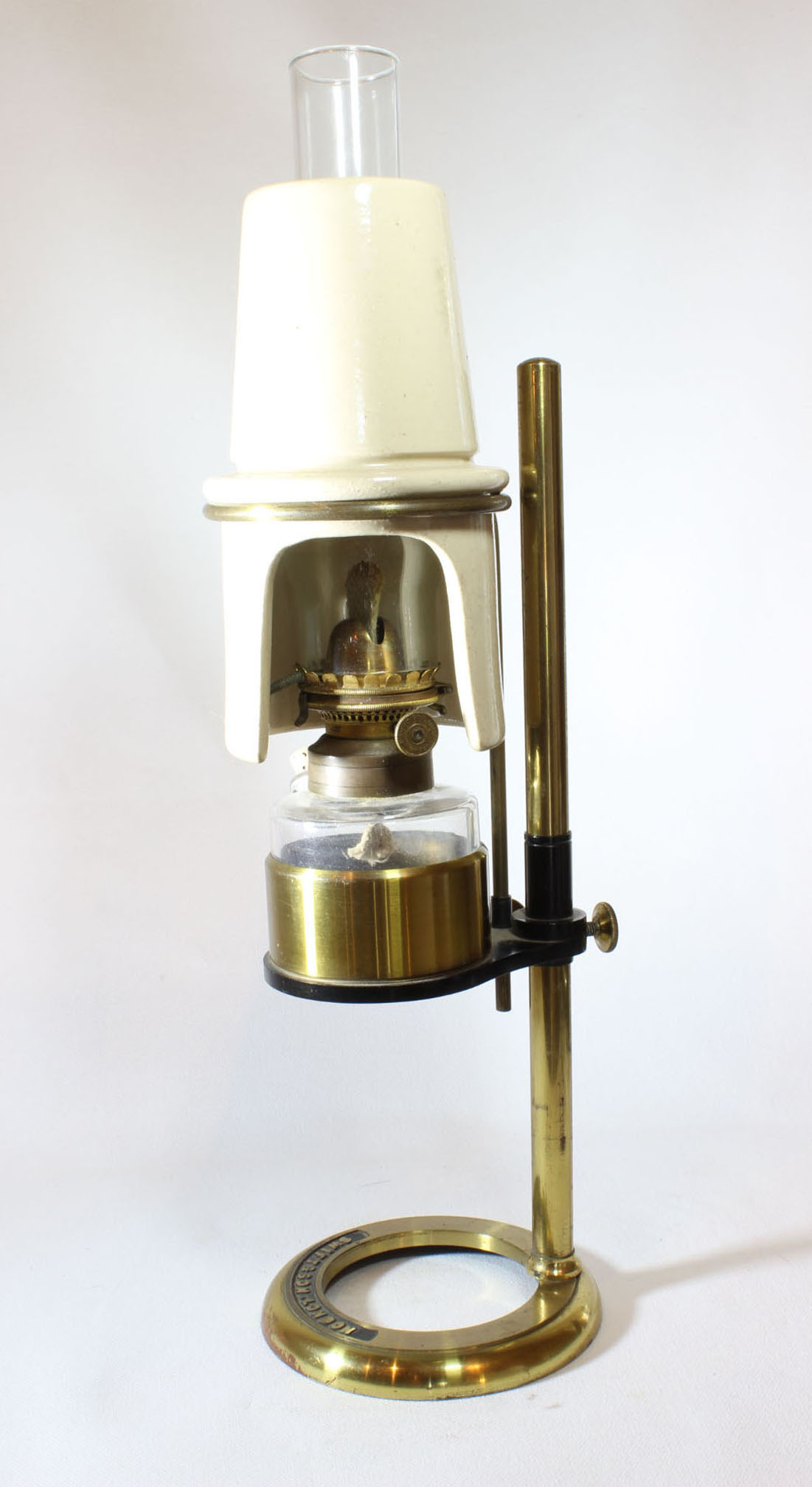
Kerosene, also known as coal oil(in the U.S.A.), paraffin oil or simply 'paraffin,' (especially in England), became widely available in the 1850's to 60's. With Kerosene relatively inexpensive, and burning brighter than prior oils, it became popular and relatively inexpensive. Camphor was sometimes added to the Kerosene to reduce its odor. According to Dr Brian Bracegirdle, this mixture should not be confused with the use of an (explosive) turpentine derivative known as camphene, which was not used for powering lamps for microscopy. The paraffin lamps, as they came to be called, varied a bit and included those with an all-glass chimney, a glass reservoir, and a porcelain hood. This type was supplied by many makers including Watson and Swift. The example shown to the left is by Swift. This type of lamp has the advantage of a ceramic hood which would be cooler than a bare chimney, while at the same time being a disadvantage, requiring additional support for the (heavy) porcelain hood. Although this form was developed earlier than those with tin chimneys, both types remained available after the tin type was introduced.
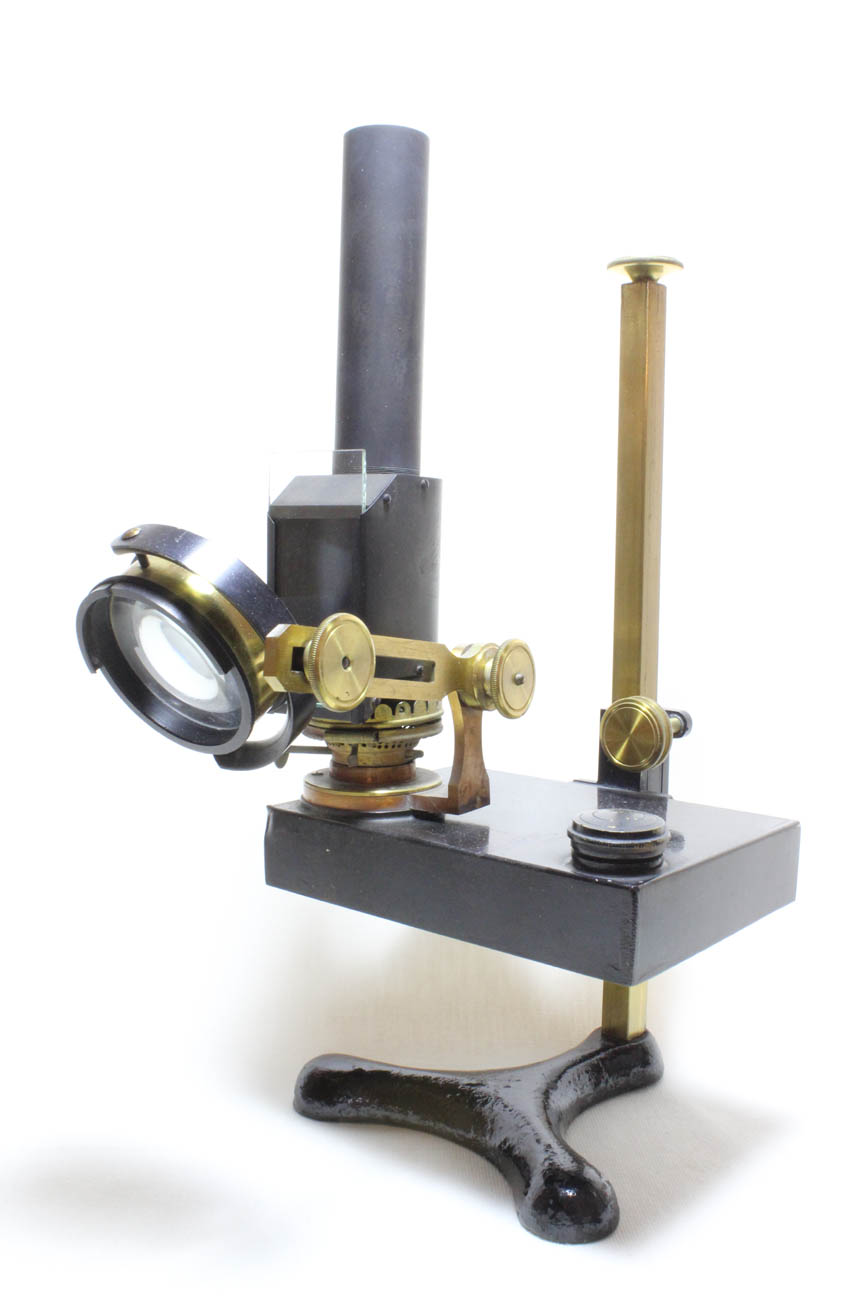
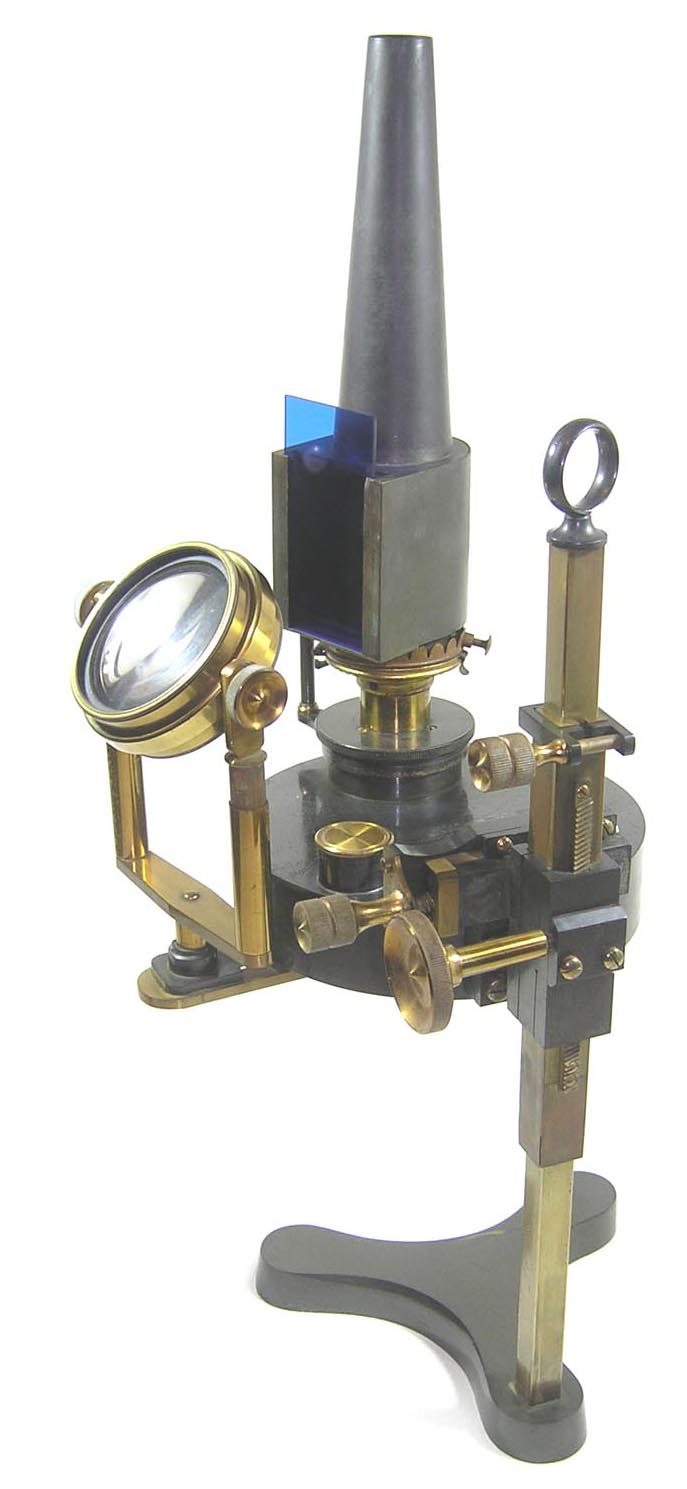
A little later, a form with with a glass insert and a tin chimney and reservoir was introduced (left). This model, when complete with optional rack and pinion vertical motion, and screw controlled right-left motion, and especially a Nelson-corrected bullseye condenser, was called the 'Nelson-Dallinger Model' and was introduced in the 1880's by Swift & Son. It was noticed in the JRMS in 1885. The more basic example to the left has clamp fittings, not fine motion controls. Watson made a similar design, their Premier
Model (right) which also provided the corrected bullseye, as well as rack and pinion fine movement both up and down and also right or left. As shown below in the table of offerings by Watson, oil lamps remained popular even until the middle of the twentieth century.
Edward Miller and Company was a highly innovative and aggressive American company that held many patents, and aggressively exported their burners all over the world and in particular to England. Watson frequently used Miller burners for their lamps, and both Watson lamps on this page have signed Miller burners, although Watson also used burners made by other manufacturers.
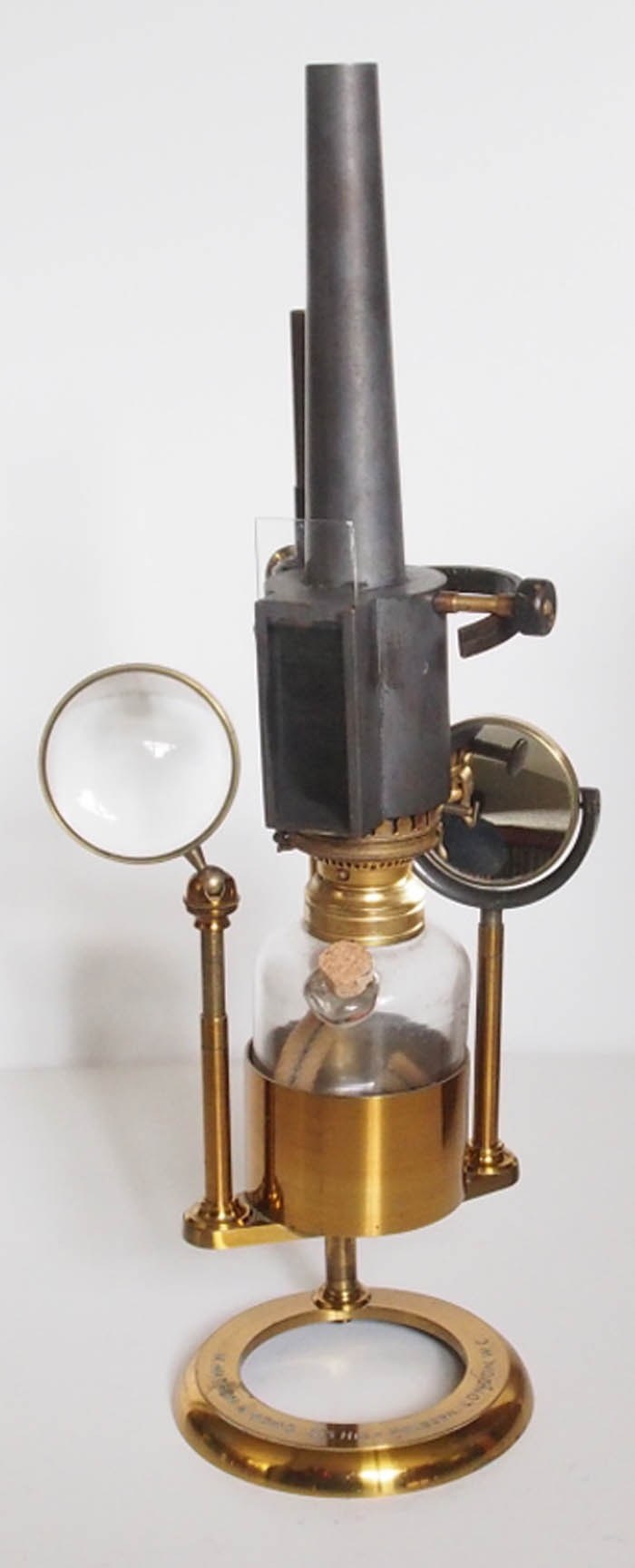
This lamp, also by Watson, includes not only a bullseye condenser but also a concave mirror to allow the user the choice of using direct or reflected light. Reflected light is intrinsically achromatic and aplanatic. (Collection of Dr. Jurriaan de Groot).
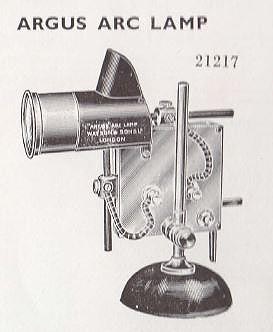
When stronger lighting was needed, and as the technology permitted, electric lights were used. One of the earliest types of brighter lamps using electricity was the Carbon Arc lamp, invented in the 1880's. This lamp, an example by Watson shown to the right, produced a very bright light, but burned up the carbon rods quickly and produced intense heat and smoke.
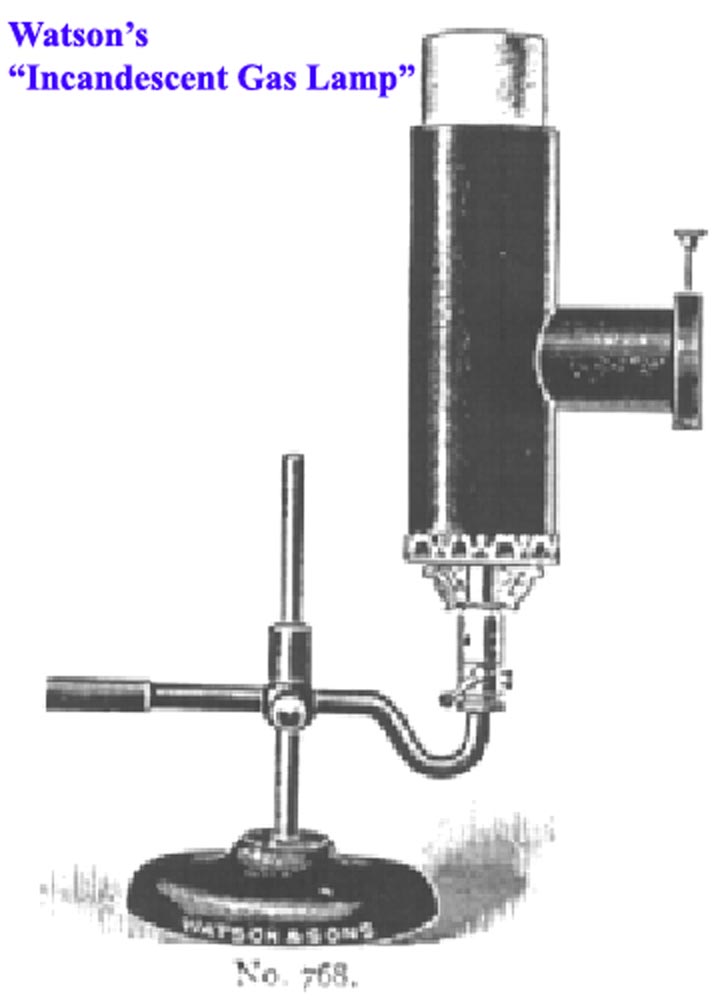
As coal gas became available, gas lamps became available. But gas alone, whether coal gas or natural gas, produces a faint light source. Gas lamps, like the one shown to the left, were sometimes used with microscopes. Since gas lamps produce a faint light, and the gas flame alone was not a bright light source, a mantle made of fabric impregnated with rare earth oxides made these lamps useful as brighter light source and they were known as incandescent
lamps. The use of Mantle-equipped gas lamps for microscopy started about 1887.
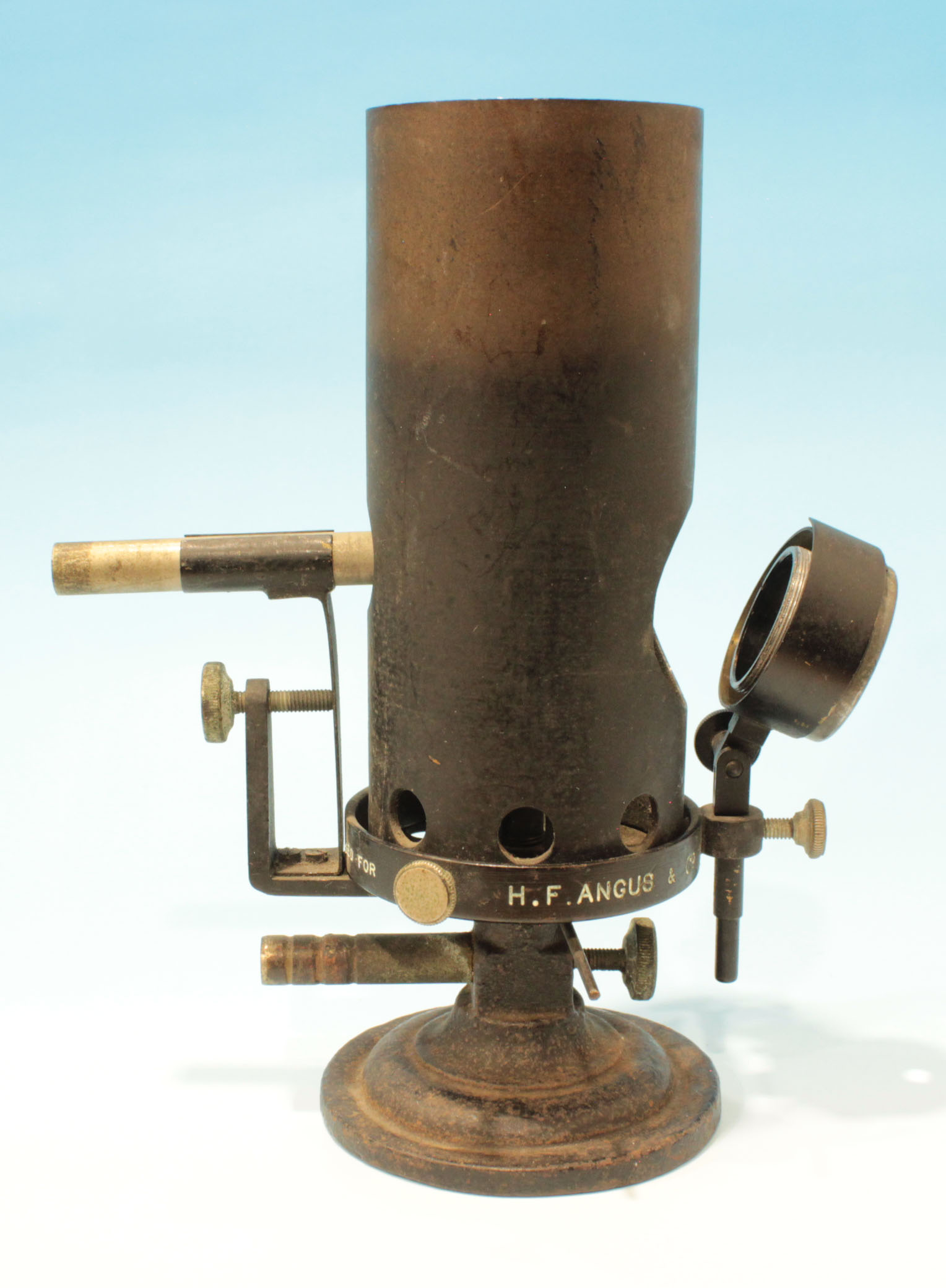
Gas lamps continued to be developed into the 20th century and new designs were invented as late as 1918. The lamp shown to the left, reported in the JRMS of 1918, was designed by the famous photomicrographer C.E. Barnard, and sold by the H.P. Angus company. It uses a pointed solid rod of 95% thorium and 5% cesium as a mantle. The burner is a Bunsen type with a fan-shaped flame. It has adjustments for gas flow rate, air flow, and a fine adjustment for the position of the mantle rod. This produced a very bright point of light about 5 mm across. It also produced some airborne radioactive material, though supposedly not in toxic amounts (?). This lamp could be powered by gas or pressurized alcohol. The example shown here is a rare surviving example. Gas lamps were offered up until the beginning of WWII, as electricity was not provided to most locations in England until after the war.
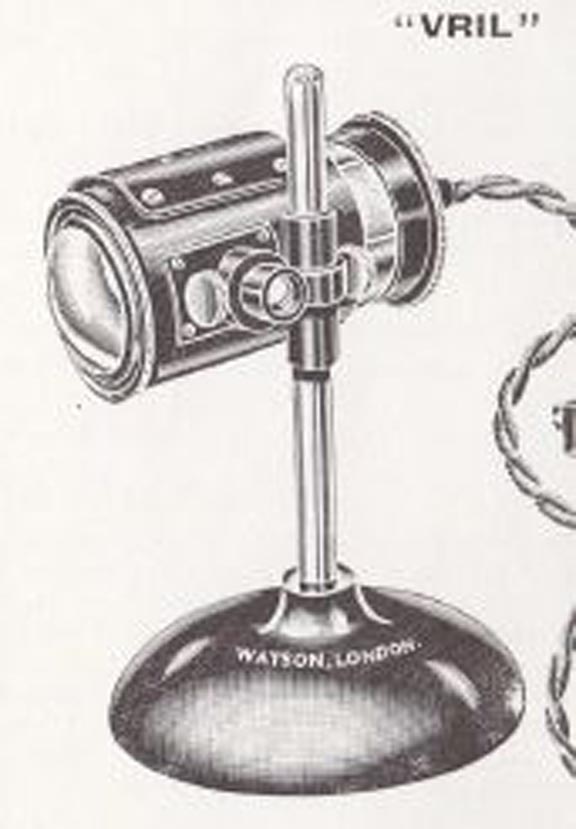
Many variations on electric microscope illuminators were developed over the years. Specific electric bulb filaments were developed for work with microscopes, including the bright and steadily lit, ribbon filament, still available in 1945. There was some limitation in brightness however, and for extremely bright lighting (as was helpful for photography), the carbon-arc lighting system was still used, and also still offered in 1945.
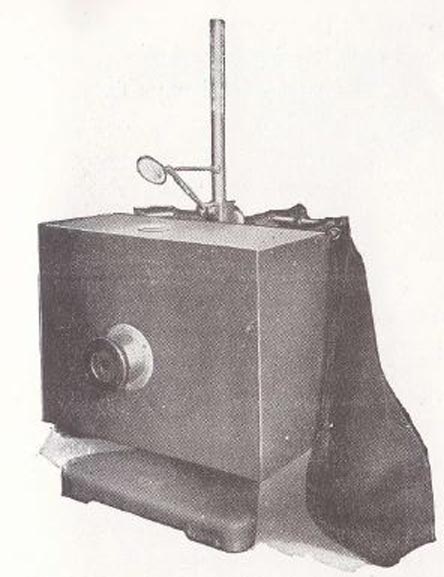 Later, mercury vapor lamps, like the one sold by Watson and shown to the left, were developed starting in the 2nd quarter of the 20th century. Although Mercury Vapor lamps do not produce smoke, just like the carbon arc lamp, they produce extreme heat.
Later, mercury vapor lamps, like the one sold by Watson and shown to the left, were developed starting in the 2nd quarter of the 20th century. Although Mercury Vapor lamps do not produce smoke, just like the carbon arc lamp, they produce extreme heat.
As technology advanced, brighter lamps with simpler, safer, and cooler technology were developed, culminating in the LED (light-emitting diode) technology of today.
It is interesting to note, that, as late as 1945, Watson offered not only electric lamps of various kinds, including mercury vapor lamps and carbon arc lamps, but that they still offered oil lamps. Oil lamps apparently served as quite adequate microscope light sources for over 150 years.


 From the earliest days of the microscope, artificial illumination was common, particularly on cloudy days or at night. At the times of the first microscopes, candles and oil lamps were the earliest illuminants. Candles were at first made from tallow, an animal fat derivative which did not burn very brightly and gave off foul smelling fumes. Starting in the late 18th century, the first major change in candlemaking since the Middle Ages occurred, when spermaceti, a wax obtained(unfortunately) by crystallizing sperm whale oil, became available in quantity. The spermaceti wax did not elicit a repugnant odor when burned, and produced a significantly brighter light. These more expensive candles were bright enough to allow better use of the microscope by candle light. Candles could be used on a separate stand designed to hold them, or a device using the microscope's own support could form the basis of the candle holder, as shown in these images. When a candle was used as the light source, a shade was often used to block the direct candle light from the eyes. An example of one of these shades is shown on the candle illumination page. Starting in the second half of the 19th century, distillation of coal oil left behind a sold residue of parafin. This became the standard material for candles.
Today, most candles are made from paraffin wax, now a byproduct of petroleum refining. Candles can also be made from beeswax, gel (a mixture of polymer and mineral oil), or some plant waxes like palm, carnuba etc. Beeswax has always been expensive however.
From the earliest days of the microscope, artificial illumination was common, particularly on cloudy days or at night. At the times of the first microscopes, candles and oil lamps were the earliest illuminants. Candles were at first made from tallow, an animal fat derivative which did not burn very brightly and gave off foul smelling fumes. Starting in the late 18th century, the first major change in candlemaking since the Middle Ages occurred, when spermaceti, a wax obtained(unfortunately) by crystallizing sperm whale oil, became available in quantity. The spermaceti wax did not elicit a repugnant odor when burned, and produced a significantly brighter light. These more expensive candles were bright enough to allow better use of the microscope by candle light. Candles could be used on a separate stand designed to hold them, or a device using the microscope's own support could form the basis of the candle holder, as shown in these images. When a candle was used as the light source, a shade was often used to block the direct candle light from the eyes. An example of one of these shades is shown on the candle illumination page. Starting in the second half of the 19th century, distillation of coal oil left behind a sold residue of parafin. This became the standard material for candles.
Today, most candles are made from paraffin wax, now a byproduct of petroleum refining. Candles can also be made from beeswax, gel (a mixture of polymer and mineral oil), or some plant waxes like palm, carnuba etc. Beeswax has always been expensive however.  As illustrated by Hooke's book of 1665, Micrographia, oil lamps were also used early on. These early lamps burned with an irregular flame and produced considerable smoke. Even at this early date, the light of the flame was intensified through the use of large lenses, in Hooke's case first through a water-filled glass globe serving to concentrate the light. This early practice of using optical means to intensify and concentrate the light gave rise to the later 'bullseye' condenser. Higher quality oil was also relatively expensive until the discovery of Kerosene* in 1859. As illustrated by the Pritchard microscope from the mid-19th century shown in the preceding paragraph, the use of candles overlapped with oil lamps for a considerable period of time. Among oils used for the lamps early on were olive oil, whale oil, colza oil(from the seeds of Brassica arvensis), and other oils derived from animals. These oils are highly viscous and early lamps using these oils burned with variable flame intensity and with much smoke.
As illustrated by Hooke's book of 1665, Micrographia, oil lamps were also used early on. These early lamps burned with an irregular flame and produced considerable smoke. Even at this early date, the light of the flame was intensified through the use of large lenses, in Hooke's case first through a water-filled glass globe serving to concentrate the light. This early practice of using optical means to intensify and concentrate the light gave rise to the later 'bullseye' condenser. Higher quality oil was also relatively expensive until the discovery of Kerosene* in 1859. As illustrated by the Pritchard microscope from the mid-19th century shown in the preceding paragraph, the use of candles overlapped with oil lamps for a considerable period of time. Among oils used for the lamps early on were olive oil, whale oil, colza oil(from the seeds of Brassica arvensis), and other oils derived from animals. These oils are highly viscous and early lamps using these oils burned with variable flame intensity and with much smoke. 








 Later, mercury vapor lamps, like the one sold by Watson and shown to the left, were developed starting in the 2nd quarter of the 20th century. Although Mercury Vapor lamps do not produce smoke, just like the carbon arc lamp, they produce extreme heat.
Later, mercury vapor lamps, like the one sold by Watson and shown to the left, were developed starting in the 2nd quarter of the 20th century. Although Mercury Vapor lamps do not produce smoke, just like the carbon arc lamp, they produce extreme heat.